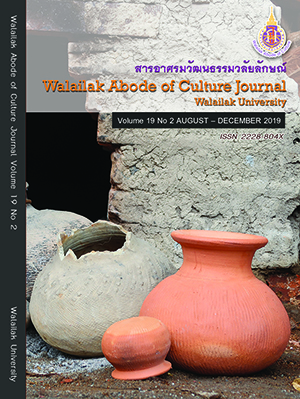Political and Religious Relation between Sri Lanka and Thailand in 13th Century
Keywords:
Relation, Sri Lanka, ThanilandAbstract
Although relationship between Sri Lanka and Thailand appears for long time, but evidence of Sri Lanka emphasizes since 13th century. During this time, Tambralinga kingdom of Thailand progresses and is well known of foreign countries. Relationship of both countries in this time is important about politics and religious issues. For political part, it appears as belligerent. For religious part, it appears as mutual support. During this time, Tambralinga kingdom of Thailand contains of powerful navy and invades Sri Lanka. The evidence of Sri Lanka ensures that aim of Tambalinga kingdom is to hold the Buddha Relic. Another view shows that Tambalinga kingdom wants to control trade route of sea because of decay and decline of Chola Empire during this time. Religious speaking, both country assists mutual. Previously, the Lankavamsa spreads and is well known for the countries of the south-east Asia. For the time of Dambadeniya kingdom, Buddhism in Sri Lanka reaches degeneration because of continual war. Buddhist monks of Tambalinga kingdom are invited for revival of Buddhism in Sri Lanka. Mutual religious support reduces political tension of both countries.
References
Codrington, H.W. (1994). A Short history of Ceylon. New Delhi, India: Asian Educational Services.
de Silva, C. R. (2001). Sri Lanka: A history. New Delhi, India: Vikas Publishing House.
Dhammavisuddhi, Y. (1970). The Buddhist Sangha in Ceylon (circa 1200-1400 A.D.). (Ph.D.’s Thesis, University of London, England).
Fine Arts Department. (1969). Record of relationship between foreign countries in 12nd Century part 1. Translated by Pairot Keitmeinkit. Phranakhon, Bangkok: Thailand: The Teacher Council of Thailand.
Godakumbura, C. E. (Ed.) (1956). Hatthavanagallaviharavamsaed. London, England: P.T.S.
Gunawardana, R.A.L.H. (1979). Robe and Plough. AZ: The University of Arizona Press.
Hettiaratchi, D. E.. (1960). History of Ceylon, Vol. I, part II. Colombo, Sri Lanka: Ceylon University Press.
Kerdsiri, K. (2017). The Great Stupa of Nakhon Si Thammarat. Bangkok, Thailand: E.T. Publishing
Liyanagamage, A. (1967). The Decline of Polonnaruwa and the Rise of Dambadeniya.Colombo, Sri Lanka: the Department of Cultural Affairs.
Malalasekera, G. P. (1994). The Pali Literature of Ceylon. Kandy, Sri Lanka: Buddhist Publication Society.
IIangasinha, H. B. M. (1992). Buddhism in Medieval Sri Lanka. Delhi, India: Sri Satguru Publication.
Inscription in Thailand Vol.1. (1986). Bangkok, Thailand: Phappim Publication.
Inscription in Thailand Vol.5. (1986). Bangkok, Thailand: Phappim Publication.
Ishii, Y. (1998). The junk trade from Southeast Asia: Translation from the Tosen Fusetsugaki 1674-1753. Singapore: Institute of Southeast Asia Studies.
Liuchaichan, B. (2012). The Establishment of Sri Lankan Buddhism in Thailand during the Dvaravati Period. Bangkok, Thailand: Smapan Publication.
Munoz, P. M. (2016). Early Kingdoms of the Indonesian Archipelago and the Malay Peninsula: Editions Didier Millet.
Munoz, P. M. (2006). Early Kingdoms. Singapore: Editions Didier Millet.
Noonsuk, P. (1982). Archeologicald document of The South of Thailand on Srivijaya Kingdom. Bangkok Thailand: Krungsiam Publication.
Noonsuk, P. (2001) The History of Nakhon Si Thammarat: The development of states on the Thai Peninsula from the sixth to the fourteenth centuries A.D. (Ph.D. Thesis, Chulalongkorn University, Thailand).
Ratnapala, N. (1971). The Katikavatas: Laws of the Buddhist Order of Ceylon from the 12th Century to the 18th Century. Munchen, Germany: Mikrokopie GmbH.
Paranavitana, S. (1966). Ceylon and Malaysia. Colombo, Sri Lanka: Lake House Investment.
Phrabodhirangsi. (1963). A story of Phrabuddhasihing: The chronicle of Phrabuddhasihing. Translated by Pol.Lt. Seng Manavitur. Bangkok, Thailand: Fine Arts Department.
Phrabodhirangsi. (2011). A Story of Chammadevivamsa of Haribhunchai. Translated by Phrayapariyatthammathada (Pea Talalakma) and Phrayanwichit (Siddhi Locananon). Nontaburi, Thailand: Sripanya Publication.
Phramahanamathera. (2010) Mahavamsa vol.2. Translated by Sutep Promlerd. Bangkok, Thailand: Mahachulalonkornrajavidyalaya Publication.
Phranibbanasotra. version of Southern Cultural Institute 1. (1985). Bangkok, Thailand: Krungsiam Publication.
Phraratanapanyathera. (2007). Jinakalamalipakorn. Translated by Pol.Lt. Seng Manavitur. Bangkok, Thailand: Ramthai Place.
Piyakul, C. (1995). A Study of the Legend “Phlao Nang Lued Khao” of Wat Khian Bang Kaeo, Amphoe Khao Chaison, Changwat Patthalung. (Master’s Thesis, Srinakharinwirot University, Thailand).
Piyakul, C. (2010). Endowment of Wat Huamueng Patthalung. Songkla, Thailand: The Institute for Southern Thai Studies, Thaksin University.
Rajavaliya. (2000). Translated by A.V. Suraweera. Ratmalana: Vishva Lekha.
Reed, A. (2005). The Southeast Asia in Trading Aged 1450-1680 Centuries vol.1: The land under the wind. Translated by Pongsri Lekhawattana. Bangkok, Thailand: The Thai Research Fund.
Sastri, N. (1929). The Pandyan Kingdom. London, England: Luzac & Co.
Srisuchat, A. (2014) Srivijaya in Suvannadvipa. Bangkok: Rungsilkarnpim Company.
Wallibhodome, S. (2005). Ancient community in the South Source of Civilization in Thai peninsular. Bangkok, Thailand: Pimdee.
Wheatley, P. (1966). The Golden Khersoness. Kuala Lumpur, Malaysia: University of Malaysia Press.
Wickremasinghe, D. M. Z., Codrington, H. W., Paranavitana, S., & Ceylon. (1994). Epigraphia Zeylanica: Being lithic and other inscriptions of Ceylon ... 1904-1934. New Delhi, India: Asian Educational Services.
Thamkirati, K. (2007). The Relations between Nakhon Si Thammarat and Ayutthaya from the Mid-Fifteenth Century to the End of the Eighteenth Centuries A.D. (Master’s Thesis, Silpakorn University, Thailand).
The Chronicle of Nakhon Si Thammarat City. (1938). Phranakhon, Thailand: Yimsri Publication.
The Chronicle of Stupa of Nakhon Si Thammarat. (1928). Phranakhon, Thailand: Phosonpipattanakorn Publication.
The Inscription Annals part 1. (1978). Banghkok, Thailand: Cabinet Publishing and Gazettes Office.
The Nikaya Sanghahawa. (1908) Translated into English by C.W. Fernando. Colombo: H.C. Cottle, Government Printer, Ceylon.
Pongsripian, W. (2011). Inscription of Chandrabanu Sriraja: Memorial Heritage of Nakhon Si Thammarat in 100 Important Documents: Variety of Thai History 10 rank. Bangkok, Thailand: The Thai Research Fund.
Sirisena, W. M. (2016). Sri Lanka and South-East Asia. Colombo, Sri Lanka: S Godage & Brothers.
Downloads
Published
How to Cite
Issue
Section
License
© 2018 by Asian Journal of Arts and Culture, Walailak University. All rights reserved.




